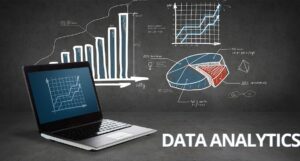Getting Started With Data Analytics
Many business professionals use the term data analytics. However, few truly understand what the term really means and how to take advantage of various analytics tools. So, read on, and you will learn more about getting started with data analytics.

Data Analytics In A Nutshell
To understand practical data analytics uses, we must first understand its science. In sum, data analytics refers to business professionals analyzing data and drawing conclusions from those analyses. While you can conduct the analysis manually, computers perform almost all analytical efforts in today’s environment.
Business professionals perform analytics for many reasons. Among them are:
- Understanding what caused a specific set of results;
- Optimizing overall business performance;
- Identifying which course of action yields the best results; and
- Analyzing data to identify suspicious or fraudulent transactions.
Four Types Of Data Analytics
Generally, most professionals who engage in data analytics efforts agree that four types of data analytics are available – descriptive, diagnostic, predictive, and prescriptive.
Descriptive Analytics
As implied by its name, descriptive analytics is useful when answering “what happened.” For example, most reports generated by accounting, ERP, and similar systems provide descriptive data. To illustrate, we can create reports that identify sales by salesperson, thus describing each salesperson’s performance. But these reports do not tell us why one salesperson struggled and another had great success. To answer these questions, we would need to focus on diagnostic analytics.
Diagnostic Analytics
As inferred above, diagnostic analytics helps answer the question “why.” For example, with diagnostic analytics, we might be able to identify how much of an increase in sales was attributable to each of the following three factors:
- An increase in advertising expense,
- Decrease in interest rates, and
- Paying special incentives to salespersons for generating higher sales.
Predictive Analytics
Closely related to diagnostic analytics is predictive analytics. Predictive analytics seeks to identify relationships in the data to create reasonably accurate forecasts of future activity. To illustrate, an auditor or business analyst might use regression analysis to forecast future factory payroll expenditures based on estimated amounts of inventory production. Accountants and auditors can use predictive analytics to establish a “baseline” for measuring achieved results.
Prescriptive Analytics
Prescriptive analytics is the fourth type of data analytics and the group’s most complex. This form of data analytics uses models to predict results and then suggests the best course of action to optimize results. Stated simply, prescriptive analytics answers the question “what should happen.” To illustrate, a data analyst could create an analytical model forecasting total revenue of $20 million in the upcoming fiscal quarter. Then, the analyst might use a model built on prescriptive analytics to specify the best course of action to generate the $20 million in revenue with the least expense. In this example, prescriptive analytics prescribes the steps necessary to optimize results.
Data Analytics Tools
Of course, you can take advantage of numerous tools today to assist with your analytics efforts. Microsoft Excel is likely the commonly-used tool for analytical efforts today. Activating and using Excel’s Analysis Toolpak can benefit those who need to calculate descriptive analytics. With the Analysis Toolpak, you can generate descriptive statistics and histograms. You can also perform regression analyses and use their results in predictive analytics exercises.
Additionally, Excel offers the Analyze Data feature, a tool that automatically summarizes and analyzes data for you. With Analyze Data, you no longer need to write formulas to identify outliers and get answers to the questions you have about your data – this tool does the work for you. You can even use Natural Language queries to “ask questions” about your data. Unfortunately, not all Excel users have access to Analyze Data. Presently, this tool is available only in versions of Excel provided through Microsoft 365/Office 365 subscription models. For more information on the capabilities of Analyze Data, see the article posted by Microsoft at Analyze Data in Excel (microsoft.com).
Two additional Excel features you can use in data environments are the FORECAST.ETS function and the Forecast Sheets tool. You can use the FORECAST.ETS function to generate predictions of future activities – such as sales – based on seasonal trends. Similarly, you can use Forecast Sheets to create forecasts of future activities. However, Forecast Sheets also provides the option of incorporating confidence intervals into your predictions. Of course, both FORECAST.ETS and Forecast Sheets are examples of tools that are helpful in predictive analytics activities.
Power BI As An Analytics Tool
Microsoft’s Power BI platform can be valuable when engaging in data analytics activities. For example, you can quickly generate descriptive analytics on data sets linked into Power BI by using one of nine summarization options. However, one of Power BI’s analytics strengths lies with its’ Quick Insights feature. Similar in some respects to Excel’s Analyze Data tool, Quick Insights is capable of analyzing large amounts of data and providing high-level summaries to help you discover trends, anomalies, and other vital points derived from your data.
Other analytics options available in Power BI include:
- Identifying outlier observations using Data Analysis Expressions or scatter charts;
- Grouping and bin analysis;
- Changing summarization measures to percent of grand totals, percent of column totals, and percent of row totals; and
- Creating forecasts of future activities, complete with confidence intervals.
Indeed, many other options could generate data analytics. However, Excel and Power BI are likely to be the tools used most often for those just getting started in this field.
Summary
Organizations of all sizes are embracing data analytics – and for good reasons! This discipline can help improve performance, answer questions, and identify outlying transactions. Further, the barriers to entry are all but nonexistent, with tools such as Excel and Power BI offering excellent analytics options. So, no matter your role or the size of the organization you serve, getting started with analytics is all but a necessity in today’s business climate.
To learn more about data analytics, consider participating in the “The How’s And Why’s Of Data Analytics” at a K2 Enterprises Technology Conference. We are pleased to also a four-hour seminar entitled “K2’s Data Analytics For Accountants And Auditors.”
